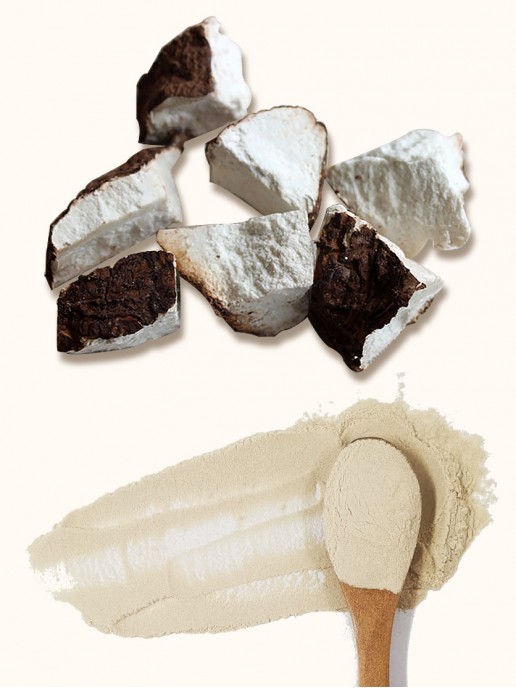
Produced by QIN SHAN TANG
- Stock: In Stock
- Model: Poria-cocos-glucan







Poria Cocos is also Known as Fu Ling, and it has a long history of use in Traditional Chinese Herbalism (TCM). It grows like a tuber under the ground and resembles a brown potato or coconut. If you look at a photo, Poria cocos may look like chopped tofu which is unlike any traditional cap and stem variety you’re probably used to seeing. It is actually a sclerotium is essentially a hardened fungal mass that holds food reserves. One specific role of sclerotiums is to survive in extreme environments. Another notable sclerotium is Chaga. It is a wood-decay fungus that grows subterranean. Poria cocos is an underground sclerotium that resembles a small coconut. Pharmacological studies reveal that polysaccharide is the most abundant substance in Poria cocos and has a wide range of biological activities including antitumour, immunomodulation, anti‐inflammation, antioxidation, anti‐ageing, antihepatitis, antidiabetics and anti‐haemorrhagic fever effects.
HIGHLIGHTS
√. Di Tao Origin -Our Poria Cocos mushroom source from the Dabie Mountains, Jinzhai Country, Anhui Province, China.
√. Organic Certified - Our Poria Cocos mushroom extract is USDA & EU organic certified.
√. 100% Fruit Bodies - Unlike most mushroom products in the market that use mycelium, our Poria Cocos extract comes from the fruiting bodies of Poria Cocos to ensure a 100% real mushroom with no grains, no additives, and no fillers.
√. Duanwood Poria Cocos - Our Poria Cocos mushroom is grown on Pine logs in our organic mushroom farms, where Poria Cocos grows naturally as similar as the growth medium in wild.
√. 100% Water-soluble - Our Poria Cocos extract powder is 100% water-soluble, it is different from other products on the market. Water-soluble beta-glucan is more easily absorbed by the body.
BENEFITS OF PORIA COCOS
√. Support a healthy mood
√. Supports a healthy urinary tract
√. Provides adaptogenic support
PORIA COCOS EXTRACT USES
Our mushroom extracts are commonly used as nutraceuticals, dietary and nutritional supplements. They are also used as a component ingredient of nutritional supplements and vitamins. Mushroom extracts are also used in many food products including but not limited to meal replacement and energy bars, snack bars, fruit, and vegetable-based drinks, milk and creamer-based beverages, sauces and seasonings, chocolates, teas, and coffee and coffee substitutes.
QUALITY COMMITMENT
Since 2000, Qinshantang has focused on the development and manufacture of medicinal mushroom extracts and Traditional Chinese Medicine for the health and wellness industry. Our unique extraction technique and the supply chain of herbal cultivation have been perfected over 20 years which is your guarantee of a safe, certain, and highly effective product. We mostly care about the effectiveness and quality of our products. We believe that this is very important for your brand's initial word-of-mouth accumulation. This is the core competitiveness of our brand which is different from other suppliers.
And if you are wondering how we are able to produce such high-quality products in China, please read more about the extensive quality control measures we take.
Specifications Of The Mushroom Extract We Have:
Beta-glucan levels: 10%, 20%, 30%, 40% (Extracted from fruiting bodies)
Polysaccharides levels: 10%, 20%, 30%, 40%, 50% (Extracted from fruiting bodies)
Note:
Each level specification represents one kind of product.
The contents of β-glucans are determined by the Megazyme method.
The contents of Polysaccharides are UV spectrophotometric method.
Why Do We Recommend You Choose Beta-glucan For Your Supplements?
Mushrooms have been valued for their health benefits and medicinal effects for centuries. One of the special components found from mushrooms is beta-glucan, which is predominantly composed in the fungal cell wall and is mostly composed of beta-D-glucose. In many researches, beta-glucan effectively stimulates the host immune response to defend against bacterial, viral, fungal, or parasitic infections. Moreover, it is known as biological response modifier since it primarily achieves its disease protective activity through modulating the host immune system. The stimulation of beta-glucan to macrophages, neutrophils, and natural killer (NK) cells is proved by binding to the receptor (dectin-1) of these cells and modulates the systems. In clinical applications, beta-glucan is usually used as an adjuvant to enhance the effectiveness of the medicine.
A common trend you see in the medicinal mushroom industry are various brands claiming that their medicinal mushrooms products contain high amounts of polysaccharides. This looks and sounds great on paper but this can be very misleading considering that polysaccharides can also come from starches. What we’ve discovered is that the polysaccharides in many so-called mushroom products are made up of alpha-glucans and not beta-glucans.
Mushrooms (or basidiomycetes) contain many different forms of polysaccharides but the most important compounds are identified as the beta-D-glucans. Beta-glucans come in various forms. The main one has what is known as 1-3,1-6 branching, or (1-3)(1-6) beta-D-glucans. This refers to the structural characteristics with particular designations (1-3) describing the linking pattern in the long chain molecule. (1-3)(1-6) beta-D-glucans are specific to fungi and yeast.
Oats and grains also contain beta-glucans but they have a different branching structure, which is (1-4)-beta-glucans.
The term beta-glucan refers to the beta-linked glucose molecules that form the typical fungal polysaccharide. The important difference when comparing the various sources of polysaccharides is that beta-glucans (and cellulose) are beta-linked while other forms such as starch are alpha-linked, otherwise known as alpha-glucans (α-Glucans).
So, a medicinal mushroom product should quantify the beta-glucans so you know the important medicinal compounds that much of the research is based around are present. This will help you in making an honest decision when selecting the right mushroom product.
At QinShanTang, we use the Megazyme method to measure beta-glucans and starch on all our products to show the potency and to confirm that they contain no fillers or grains.
Research On Beta-glucan:
https://www.ncbi.nlm.nih.gov/pmc/articles/PMC5919537/
https://academic.oup.com/nutritionreviews/article/69/6/299/1815168
https://www.sciencedirect.com/topics/agricultural-and-biological-sciences/beta-glucans
https://www.sciencedirect.com/science/article/abs/pii/S0955286317310070?via%3Dihub
https://www.sciencedirect.com/science/article/pii/S0147957118301000
